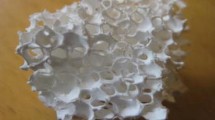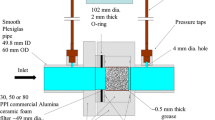Abstract
This work presents a mathematical model to compute the efficiency of depth filtration of molten aluminum using ceramic foam filters. In the model, the porous structure of foam filters was represented by a unit cell that takes into account the convergent-divergent nature of the flow field. The steady, two-dimensional, and fully developed flow field within the unit cell was obtained from the numerical solution of the continuity and Navier-Stokes equations. The assessment of the proper assumptions for the model was carried out by comparing the computed velocity field with that experimentally determined for a physical model of the unit cell with scale 10:1 and containing an aqueous solution of CaCl2. The measurements were done using the particle image velocimetry (PIV) technique. The efficiency and the coefficient of initial filtration for foam filters were obtained from the determination of the particle limiting trajectory, resulting from a force balance on a spherical inclusion. This balance included the buoyancy and the viscous drag forces. The last force took into consideration the wall effect on the particle motion. The values of the computed initial filtration coefficient show an excellent agreement with the corresponding measured ones reported for laboratory and plant tests for short-term filtration. This comparison involves several combinations of particle sizes and downward fluid superficial velocities. This model is further extended to study long-term filtration in the second part of the article.
Similar content being viewed by others
Abbreviations
- a i :
-
coefficients corresponding to the north, south, top, and bottom neighbors in the control volume discretization method, Eq. [7].
- a B , a T :
-
coefficients corresponding to the bottom (or downstream) and top (upstream) neighbors (Table III), respectively
- A :
-
fluid flow area or downstream control volume face area (m2)
- A b , A t :
-
areas of the bottom (or downstream) and top (or upstream) control volume faces (m2), respectively, and equal to ΔxΔy
- b :
-
buoyancy factor (1 − ρ/ρ p )
- C :
-
Eulerian particle concentration in the melt that flows through a filter (g/cm3)
- C i , C o :
-
particle concentration in the melt at the inlet and at the outlet of the filter, respectively
- c p :
-
particle concentration in the melt before filtration (ppm and g/cm3)
- d p , d w , d c :
-
particle, window, and pore diameters (mm), respectively
- D b , D t :
-
diffusion conductance at the bottom and top control-volume faces and equal to μ b /(z p − z b ) and μ i /(z b − z P), respectively
- E φp :
-
absolute value of the residual
- f(r):
-
vector function defining velocity profile along the radial direction (m/s)
- g :
-
acceleration of gravity (9.8 m/s2)
- h :
-
distance between successive windows (mm)
- L :
-
filter thickness (cm)
- L 1, L 2 :
-
distances from the particle center to each one of the plates that bound it (mm)
- L p :
-
half-length of separation between the plates that bound a particle (mm); in our case, it is considered to be equal to half the pore cord length measured horizontally at particle position z
- m p :
-
mass of the suspended particle (kg)
- N G :
-
gravity number defined as d 2 p (ρ p − ρ)g/18μU i
- N Re, N Re,p :
-
Reynolds numbers for the fluid, N Re = U i d c /v, and for the particle, N Re,p =U ∞ d ∞ d p /v
- p :
-
Eulerian pressure in the fluid (Pa)
- p o :
-
reference pressure in the fluid at the outlet of the unit cell (Pa)
- P b , P t :
-
Peclet number evaluated at the bottom and top control-volume faces and equal to ρu z,b (z p − z b )/μ b and ρu z,t (z t − z p )/μ t , respectively
- Q :
-
voluminic flow rate (cm3/s)
- r, z :
-
coordinate distances in the radial and axial directions, respectively (mm)
- r* e :
-
maximum radial position at which a particle can enter the unit cell (mm)
- r* l :
-
inlet radial position of the particle that follows the limiting trajectory (mm)
- r p , r op :
-
particle position and particle initial position vectors (mm), respectively.
- R :
-
radius of the suspended particle (μm)
- R c , R K :
-
radius of the collector grain and average length of roughness elements (mm), respectively
- t, Δt :
-
time and Lagrangian time-step(s)
- u :
-
Eulerian velocity vector of the fluid (cm/s)
- U i :
-
interstitial melt velocity (U m /ε) (cm/s)
- U m :
-
melt superficial velocity (Q/A) (cm/s)
- u p , u ∞ :
-
Lagrangian particle velocity and particle terminal velocity (cm/s), respectively
- u op :
-
velocity of the particle in a previous time (cm/s)
- u r , u z :
-
radial and axial components of the fluid velocity (cm/s), respectively
- u z,b , u z,t :
-
radial component of the fluid velocity at the bottom and top control volume faces, respectively
- \(\dot W_t ,\dot W_i \) :
-
mass flow rates of trapped particles and particles entering the pore (g/s), respectively
- Δx, Δy :
-
size of the control volume in the x and y directions, respectively (m)
- z b , z p , z t :
-
axial positions of the bottom face, the control point, and the top face of the control volume, respectively (m)
- Z :
-
main flow direction of the fluid through the filter
- ε :
-
filter porosity (pct)
- φ :
-
azimuthal angle, radians
- φ i , φ p :
-
values of the dependent φ variable at neighbor position i and control position P, respectively.
- η :
-
filtration efficiency of the filter defined by (C i − C o )/C i × 100 (pct)
- η 0 :
-
filtration efficiency of a pore determined from Eq. [12] (pct)
- λ, λ 0 :
-
filtration coefficient and initial filtration coefficient (m−1)
- Λ:
-
wall-effect correction coefficient for a sphere falling between two parallel plates and defined in Eq. 6
- μ, v :
-
dynamic and kinematic melt viscosities, (Pa·s and m2/s), respectively.
- μ b , μ t :
-
melt viscosity at the bottom and top faces of the control volume (Pa·s), respectively
- π :
-
constant, 3.141592654
- θ :
-
angle between the unit cell axis and the main flow direction, (rad and deg)
- ρ, ρ p :
-
density of the fluid and particle, respectively (kg/m3)
- τ :
-
characteristic time given by Eq. [10] (s)
References
Metals Handbook, vol. 15, Casting, ASM INTERNATIONAL, Metals Park, OH, 1988, pp. 489–93.
L.S. Aubrey and J.E. Dore: Proc. 122nd TMS Light Metals Annual Meeting, Denver, CO, Feb. 21–25, 1993, TMS, Warrendale, PA, 1993, pp. 1009–20.
F. Frisvold: Ph.D. Thesis, The Norwegian Institute of Technology, Trondheim, Norway, 1990, pp. 98–142.
A.H. Castillejos-E., F.A. Acosta-G., and J.M. Almanza-R.: Proc. 121st TMS Light Metals Annual Meeting, San Diego, CA, Mar. 1–5, 1992, TMS, Warrendale, PA, 1992, pp. 1113–22.
R. Mutharasan, D. Apelian, and C. Romanowski: JOM, 1981, Dec., pp. 12–17.
T.A. Engh, B. Rasch, and E. Bathen: Proc. 115th TMS Light Metals Annual Meeting, New Orleans, LA, Mar. 2–6, 1986, TMS, Warrendale, PA, 1986, pp. 829–36.
Handbook of Fluids in Motion, N.P. Cheremisionff and Ramesh Gupta, eds., Ann Arbor Science, Ann Arbor, MI, 1983, pp. 969–1000.
N.J. Keegan, W. Schneider, H.P. Krug, and V. Dopp: Proc. 126th TMS Light Metals Annual Meeting, Orlando, FL, Feb. 9–13, 1997, TMS, Warrendale, PA, pp. 973–82.
C. Tian and R.I.L. Guthrie: Metall. Mater. Trans. B, 1995, vol. 26B, pp. 537–46.
J.P. Desmoulins, H. d’Hondt, J.M. Hicter, and P. Netter: Proc. 118th TMS Light Metals Annual Meeting, Las Vegas, NV, Feb. 27–Mar. 3, 1989, TMS, Warrendale, PA, 1989, pp. 757–67.
A.C. Payatakes, C. Tien, and R.M. Turian: AIChE J. 1974, vol. 20(s) pp. 889–99.
F.A. Acosta G., A.H. Castillejos E., J.M. Almanza R., and A. Flores V.: Metall. Mater. Trans. B, 1995, vol. 26B, pp. 159–172.
F.A. Acosta G.: Ph.D. Thesis CINVESTAV, Coah., México, 1999, pp. 69–74.
Y.A. Hassan, T.K. Blanchat, C.H. Seeley Jr., and R.E. Canaan: Int. J. Multiphase Flow, 1992, vol. 18(3), pp. 371–95.
C.C. Landreth and R.J. Adrian: Proc. 4th Int. Symp. of Applications of Laser Anemometry to Fluid Mechanics, Lisbon, Portugal, July 11–14, 1988, Springer-Verlag, Lisbon, Portugal, pp. 484–97.
VISIFLOW® software, Rev. 7, AEA Technology, Oxfordshire, U.K., 1996.
C.A.J. Fletcher: Computational Techniques for Fluid Dynamics, Springer-Verlag, Berlin, 1977, vol. 2, pp. 47–48.
C. Tian and R.I.L. Guthrie: Proc. 122nd TMS Light Metals Annual Meeting, Denver, CO, 1993, TMS, Warrendale, PA, 1993, pp. 1003–07.
H. Brenner: Chem. Eng. Sci., 1961, vol. 16(3–4), pp. 242–51.
S.V. Patankar: Numerical Heat Transfer and Fluid Flow, McGraw-Hill, New York, NY, 1980, pp. 88–90.
H.I. Rosten and D.B. Spalding: PHOENICS, Software ver. 2.1.3, CHAM Ltd., London, 1996.
V.N. Burganos, C.A. Paraskeva, and A.C. Payatakes: AIChE J., 1995, vol. 41(2), pp. 272–85.
Author information
Authors and Affiliations
Rights and permissions
About this article
Cite this article
Acosta G., F.A., Castillejos E., A.H. A mathematical model of aluminum depth filtration with ceramic foam filters: Part I. Validation for short-term filtration. Metall Mater Trans B 31, 491–502 (2000). https://doi.org/10.1007/s11663-000-0155-3
Received:
Issue Date:
DOI: https://doi.org/10.1007/s11663-000-0155-3




